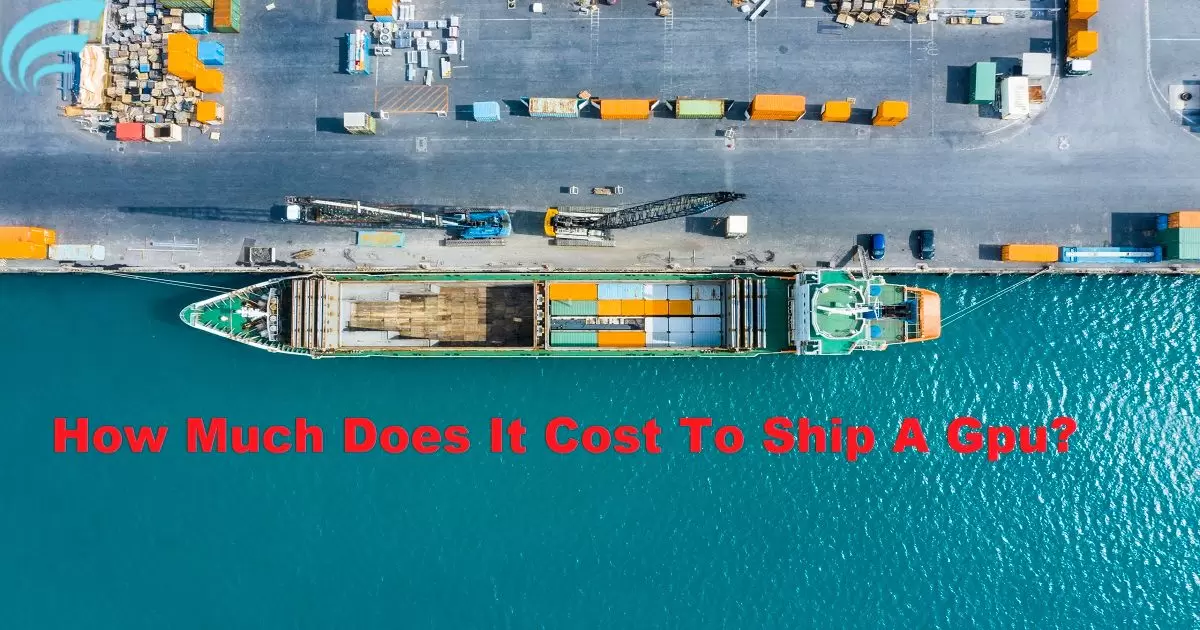Shipping a GPU involves sending a graphics card to someone, similar to posting a gift. The expenses depend on the chosen shipping method, the desired level of security, and the destination. While it may incur some costs, it’s a way to deliver your GPU to individuals located at a distance.
Curious about how much it costs to ship a GPU? Discover the key factors that affect your shipping expenses and make informed decisions to ensure a smooth and cost-effective process. Let’s dive into the world of GPU shipping costs.
Shipping a GPU involves expenses that can differ. These costs depend on various factors, such as the chosen shipping method, whether you opt for insurance, and where the GPU is being sent. Gaining insight into these cost considerations is essential for effectively planning your GPU shipment and making sure it’s both smooth and budget-friendly.
Shipping Methods
Choosing the right shipping method is the first step in determining the cost of shipping your GPU. Here are some common options:
Local Shipping
- Local Courier Services: Utilizing local courier services such as FedEx, UPS, or DHL is convenient for domestic shipments. The costs depend on the courier, package weight, and dimensions.
National Shipping
- National Postal Services: Using your country’s postal service can be cost-effective, particularly for standard mail or smaller packages. Pricing varies based on the chosen service level.
- Economy vs. Express: National postal services often offer economy and express service options. Economy services are cost-effective but slower, while express services are faster and more expensive.
International Shipping
- International Couriers: If you need to send a GPU overseas, international courier services provide secure and reliable options. The cost is typically higher compared to domestic shipping.
- Economy vs. Express: International shipments come with various service levels. Express services are quicker but come at a higher cost compared to economy options.
Packaging
Proper packaging is essential to ensure the GPU arrives safely at its destination. Consider these packaging factors:
GPU Box or Original Packaging
- Reuse the Original Box: If you still have the original packaging that the GPU came in, it offers an ideal fit and protection for shipping.
- Custom GPU Box: In case you no longer have the original box, investing in a custom GPU shipping box is a wise choice. These boxes are designed to securely hold GPUs.
- Anti-Static Bags and Padding: To protect the GPU from electrostatic discharge, use anti-static bags. Adding padding, such as bubble wrap or foam, safeguards the GPU from physical shocks during transit.
Insurance

Insurance provides peace of mind during shipping and safeguards against potential damage or loss. Here’s what you need to know:
Declared Value
- Declare the value: When shipping a GPU, declare its value. Keep in mind that the cost of shipping may slightly increase for higher declared values.
Insurance Options
- Courier Insurance: Many courier services offer insurance options, allowing you to choose coverage based on the value of the GPU being shipped. The cost of insurance varies depending on the declared value.
- Third-Party Insurance: Some third-party insurance providers specialize in shipping coverage. Explore these options to find the best coverage for your needs.
Considerations for International Shipping
If you’re shipping a GPU internationally, additional factors come into play. Make sure to take these considerations seriously:
Customs and Duties
- Customs Declarations: Provide accurate declarations on customs forms regarding the GPU and its value. Inaccurate information can lead to delays and extra fees.
- Import Duties and Taxes: Recipients may be subject to import duties and taxes, which are their responsibility.
Documentation
- Proper Documentation: Ensure all necessary documentation is completed accurately to facilitate customs clearance.
- Commercial Invoice: Prepare a commercial invoice that details the GPU’s value, purpose, and other essential information.
Cost Breakdown
Understanding the breakdown of costs when shipping a GPU is essential. It allows you to budget effectively and make informed decisions. Here’s a table that outlines the key cost components involved in shipping a GPU:
| Cost Component | Description | Cost Range |
| Shipping Method | Choice of courier service (local, national, or international) | Varies by courier and service level |
| Packaging | Use of original GPU box, custom box, and anti-static bags | Varies; custom box cost is one-time |
| Insurance | Declared value and selected insurance coverage | Varies based on GPU value and coverage |
| International Considerations | Customs duties, taxes, documentation, and handling fees | Varies by country and shipment specifics |
Tips for Cost-Effective Shipping
To keep shipping costs reasonable, consider the following tips:
- Compare Courier Rates: Get quotes from multiple courier services to find the best rate for your specific needs.
- Opt for Economy Services: If time isn’t critical, choosing economy international shipping can result in lower costs.
- Avoid Peak Seasons: Shipping during holidays and peak seasons can be more expensive. Plan your shipment timing accordingly.
- Package Efficiently: Efficient packaging can help reduce weight and, consequently, shipping costs.
- Use Online Shipping Tools: Many couriers offer online tools to estimate shipping costs, making it easier to budget.
- Bulk Shipments: If you’re a retailer or have multiple GPUs to ship, inquire about bulk shipment discounts.
Pros of Shipping a GPU
Convenience: Shipping allows you to send GPUs to buyers or recipients located far away without the need for physical presence.
Access to a Wider Market: You can reach a broader audience when selling or trading GPUs by shipping them, potentially securing better deals.
Safety and Security: Reputable courier services ensure the safe and secure transport of your GPU.
Cons of Shipping a GPU
Shipping Costs: Shipping can be costly, and expenses vary based on factors like shipping method, packaging, and insurance.
Risk of Damage: Despite secure packaging, GPUs can still be damaged in transit, leading to disputes and additional expenses.
Customs and International Considerations: International shipping involves customs, duties, taxes, and documentation, which can be complex and add to the cost and time involved.
FAQS
Is the cost of shipping a GPU the same for all couriers?
Shipping costs can vary between different courier services and even between service levels within the same courier.
How can I reduce the shipping cost for my GPU?
You can minimize costs by comparing rates, using economy services, using efficient packaging, and avoiding peak shipping seasons.
What factors affect the declared value and, consequently, the shipping cost?
The declared value of the GPU, which affects the shipping cost, depends on its market value and the chosen insurance coverage.
Are international shipping costs significantly higher than domestic shipping costs?
Yes, international shipping often costs more due to additional customs and handling fees.
Can I estimate the shipping cost before sending a GPU?
Many courier services offer online tools to help estimate shipping costs based on your shipment’s specifics.
Conclusion
To sum it up, understanding the expenses associated with shipping a GPU is crucial. The cost can vary depending on your choices, but gaining insights into the factors that influence it empowers you to make well-informed decisions when sending your valuable graphics card.
Balancing the need for secure GPU delivery with budget considerations and understanding how to hide GPU cables is key. By exploring different shipping methods, packaging solutions, and insurance options and considering international shipping intricacies, you can navigate the world of GPU shipping costs confidently.
Whether you’re selling, trading, or sending a GPU to a friend, this knowledge will help you plan a smooth and budget-friendly shipping experience. The next time you ponder how much does it costs to ship a GPU, you’ll be well-prepared to manage your expenses effectively.











